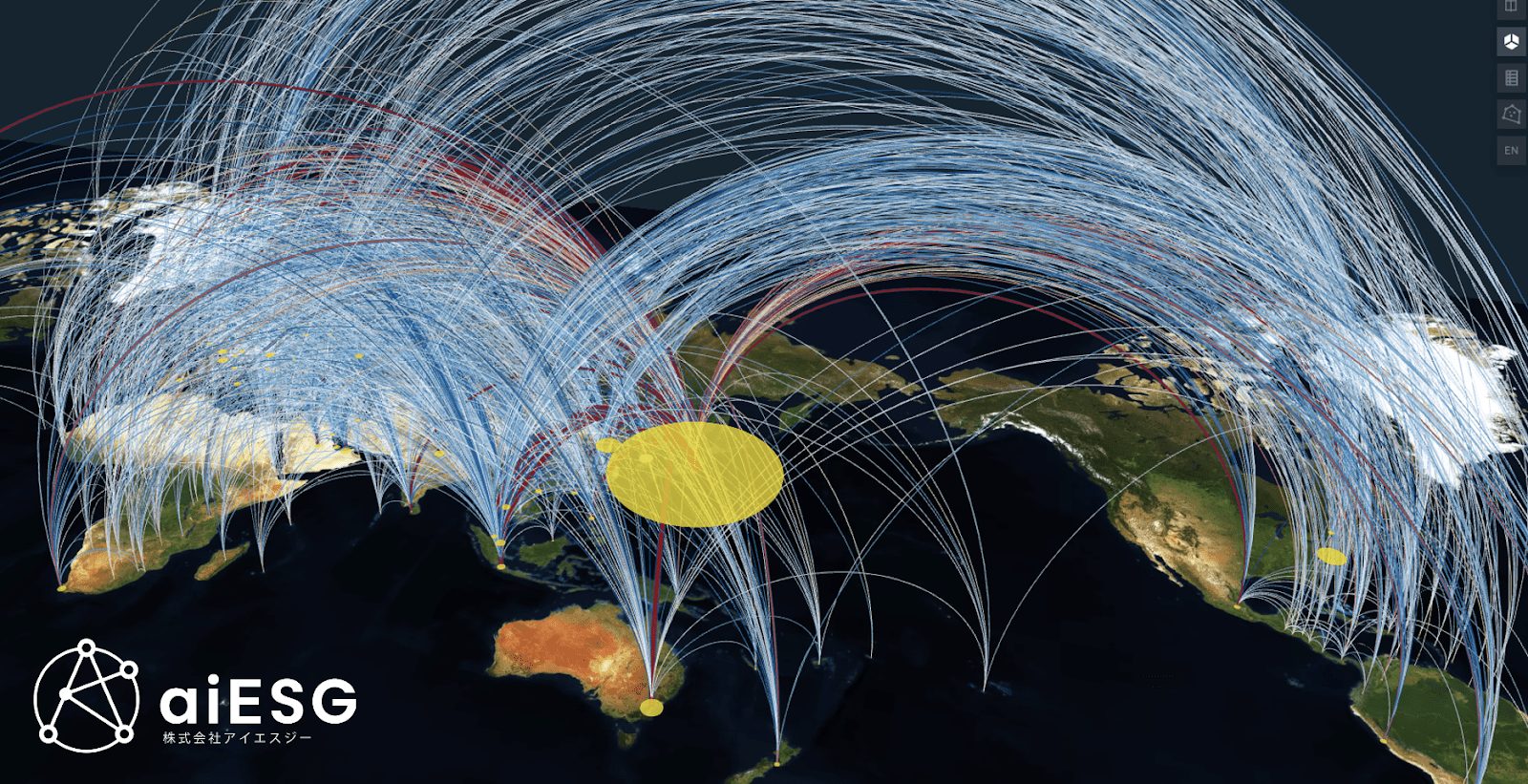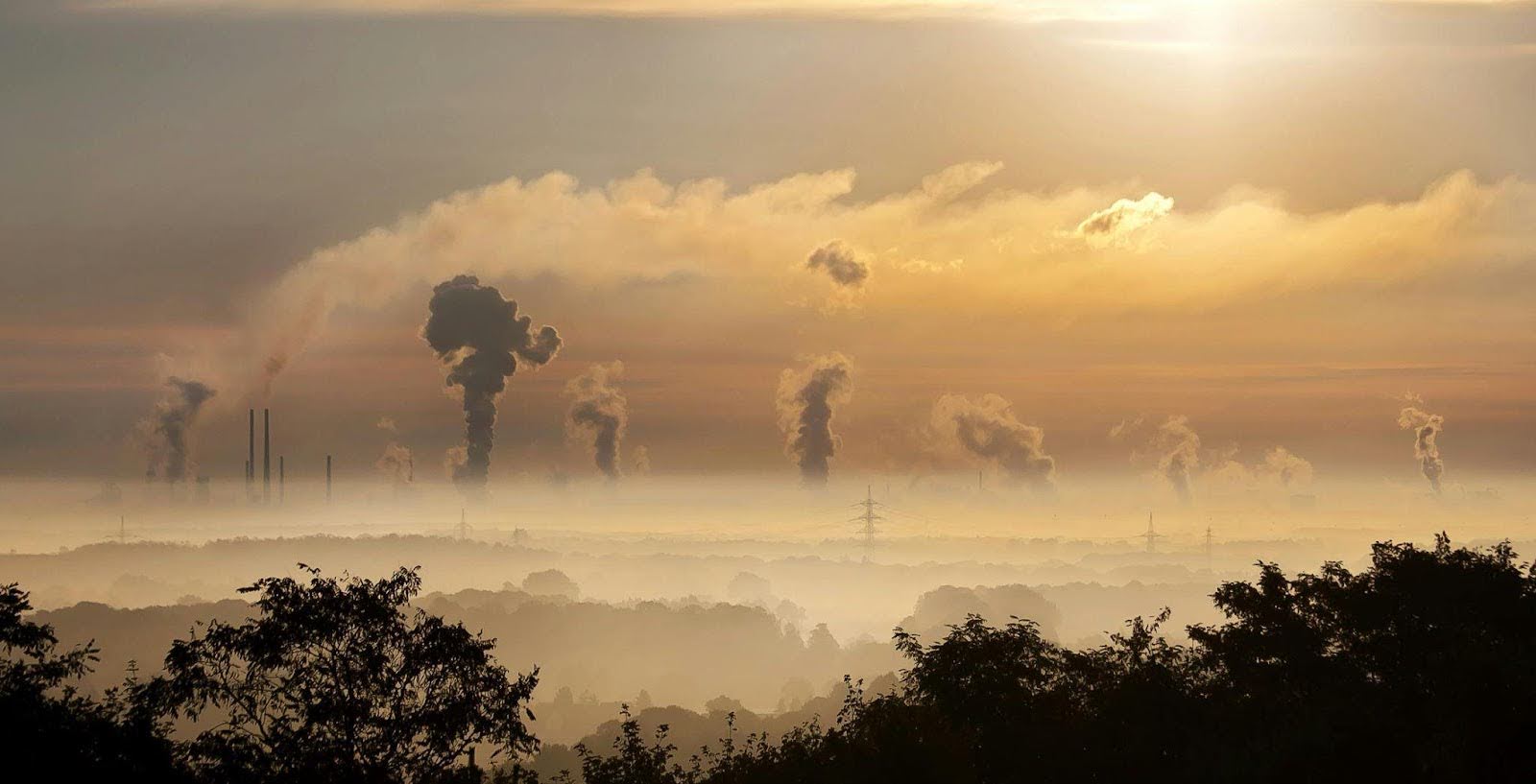INDEX
This is a Japanese translation of a manuscript written by aiESG's ESG research team and edited into three parts for publication. The English version of the manuscript isthis way (direction close to the speaker or towards the speaker)You can view it from
Please see the original article in English here.
Table of Contents:
Introduction.
Importance of supply chain impacts on the environment and society
Conclusion
Introduction.

Figure 1: Map image showing the supply chain impact of producing a certain product
Supply chains are becoming increasingly important in today's society. Supply chains link all the people, organizations, resources, activities, and technologies involved in the transformation of resources and energy into products and services through a number of processes, including extraction, transportation, production, and sales. Needless to say, in today's highly globalized world, producers and service providers, whether multinationals or SMEs, are the hub of extensive and highly complex supply chains spanning many countries and involving numerous suppliers.
Thus, a company's operations have global and local impacts on the environment (resource use, water use, energy consumption waste, carbon emissions, etc.) and society (employment practices, worker safety, community relations, etc.) through its supply chain. This means that companies are responsible for potential impacts to the planet and its people through their supply chains, even if they are unaware of these impacts or normally view them as outside the scope of their responsibility. Traditionally, companies have been concerned only with improving efficiency and controlling costs in their supply chain management, but recent trends indicate that this paradigm is rapidly changing. Companies are now aware of the potential ESG risks inherent in their supply chains1to understand and report, but also to take proactive steps to mitigate those risks and improve the ESG performance of their supply chain, and to work closely with their suppliers.
*1Risk of damage to the company due to environmental (e.g., climate change, resource depletion, pollution, loss of biodiversity), social (human rights violations, labor and community impacts), and governance (corruption, unethical behavior) impacts
This three-part series, titled "Sustainable ESG-Oriented Supply Chains: A Strategic Imperative for Modern Business," will focus on the following topics
first
Environmental and social impacts of the supply chain
Supply chain risk examples from companies and UN findings
2nd
What are the potential benefits and opportunities that would motivate companies to build a sustainable and resilient supply chain?
The Risks of Doing Nothing
Third
Necessary steps and challenges
How technology can help companies understand and improve their supply chain ESG performance
About aiESG's cutting-edge solutions
Near-future trends in the supply chain
In this first article, we will review the importance of supply chain impacts on the environment and society.
Importance of supply chain impacts on the environment and society

Supply chains have a significant impact on both the environment and society. For example, when it comes to greenhouse gas (GHG) emissions, supply chains areMore than 601 TP3T of global emissionsand accounted forLargest source of GHGsIt is. In many cases, the majority of an organization's carbon footprint is attributable to Scope 3 emissions from the supply chain (upstream emissions) and from the use and utilization of products (downstream emissions). In some industries, more than 80-90% of the overall carbon footprint is derived from Scope 3. As a result, companies are now required to take action to measure and reduce their Scope 3 emissions and to disclose and report their progress in accordance with various guidelines and regulations such as SBTi, CDP, GRI, TCFD, and ISSB.

Figure 2 Overview of the scope of the GHG Protocol and emissions across the value chain

Supply chains are not only the largest source of emissions, but also the greatest victims of climate change. Extreme weather events such as heat waves, droughts, hurricanes, and torrential rains, which are increasing in frequency and magnitude due to climate change, pose health risks to vulnerable workers and communities in resource extraction and production sites and disrupt supply chains.Recent Surveysfound that one in two CEOs is suffering from supply chain disruptions due to climate change, and 25% of CEOs say this is one of their biggest business risks.

In addition to their impact on climate change, supply chains also have significant impacts on the broader environment, including pollution, resource depletion, and loss of biodiversity.According to the United Nations.Many industries are noted to have far greater environmental impacts through their supply chain operations than through their direct business activities. For example, in the financial services, food and beverage, and banking industries, 98% of environmental impacts are attributed to the supply chain, with only 2% coming from a company's direct operations.
Therefore, it is not enough for companies to claim that their operations are green; they must also address the "unmissable issue" of supply chain management. Based on this recognition, new initiatives such as TNFD and SBTN have emerged, requiring companies to disclose information and set targets for nature-related risks (biodiversity loss, ecosystem degradation, and resource depletion) in their business activities, including upstream and downstream in the value chain.

Similarly, on the social front, the supply chain has a huge social responsibility, employing an estimated 450 million people annually (seeILO Data(See Appendix A.). Supply chains present significant human rights risks that many companies have overlooked. The deeper the supply chain, the less visibility there is, especially at the deeper levels, the greater the potential for violations and the more likely it is that significant environmental and social impacts are overlooked. Limited supply chain visibility increases the risk of human rights violations, especially in emerging markets, where companies are often unaware of negative impacts on workers and broader society. Vulnerable groups are particularly at risk, including women, migrants, and children.
Human Rights Watch on the many unethical labor practices and human rights violations in the deep supply chainWe are reportingFor example, in the apparel industry, there are many different types of products. For example, in the apparel industry,Collapse of Rana Plaza sewing factory in Bangladeshcatastrophes that claimed the lives of 1,138 workers. In the jewelry industry, there are well-known "blood diamond" cases, referring to human rights abuses related to diamond mining in conflict zones such as Zimbabwe and Angola. In the technology and manufacturing industries, scandals related to "conflict minerals" such as tantalum, tungsten, gold, lithium, and cobalt mined in conflict zones in the Democratic Republic of Congo and adjacent countries are widespread. Global automakers on the use of aluminum sourced from the Xinjiang Uygur Autonomous Region,They are accused of issues including the risk of forced labor for Uyghurs.The following is a list of the most common problems with the "C" in the "C" column.According to the ILOAn estimated 28 million people worldwide are victims of forced labor.
Human Rights Risks in Global Supply Chains:
| Forced or compulsory labor |
| human trafficking |
| toil and labour |
| Freedom of Association and Restrictions on the Right to Collective Bargaining |
| Poor, unsanitary or hazardous working conditions |
| Illegal child labor |
| overtime |
Human rights risks in dealing with suppliers (e.g. in the financial sector)
| Risk that suppliers do not pay sufficient wages and that wages are not paid by the stipulated date. |
| Risk of inducing long working hours at suppliers through transactions with suppliers |
| Risk of encouraging forced labor through business dealings with suppliers, e.g., through threats of punishment. |
| Risk of companies in the supply chain discriminating or disadvantaging without reasonable grounds in hiring, promotions, wages, etc., on the basis of race, gender, language, age, etc. |
The majority of risks associated with human rights violations and environmental degradation occur deep in the supply chain. Many companies are unaware that they may be unknowingly complicit in these violations without the necessary information about their value chain management. That information includes insight into the ethics of a supplier's business practices and a detailed understanding of the product lifecycle (geographic origin of resources, transportation routes to that company, and associated ESG risks). Until recently, companies had little incentive or expertise to address these issues. However, this is rapidly changing.
Conclusion
In the first session, the importance of supply chain impacts on the environment and society was introduced with examples of companies and the results of UN surveys. In the second session, we will explain the factors that drive companies to promote sustainable supply chains, the benefits and opportunities that can be gained by doing so, and the risks associated with inaction.
__
aiESG supports ESG analysis at the product and service level, tracing back through the supply chain. We also provide support for ESG-related frameworks, from basic content to actual disclosure of non-financial information.
Contact us:https://aiesg.co.jp/contact/
*Related Article*.
Part 2: Sustainable ESG-oriented supply chains: a strategic imperative for modern business
Part 3: Sustainable ESG-oriented supply chains: a strategic imperative for modern business
~ Steps, Correspondence, and Trends ~.
Explanation] What is TNFD? A new bridge between finance and the natural environment
[Explanation] TNFD early adopters and their characteristics
Description] SBTs for Nature - science-based nature-related goals
Commentary] IWI (Inclusive Wealth Index) - A New Index to Measure Well-Being
Commentary] Nature Positive : Realizing a Society that Can Live in Harmony with Nature - About OECM and Sites for Coexistence with Nature
Commentary] SSBJ (Sustainability Standards Board Japan) Deliberation Trends - Scope 3 Disclosure Standards in Japan
Commentary] ISSB's Latest Trends - Biodiversity and Human Capital are now under Consideration.
[Commentary] TISFD: Task Force on Inequality and Social-related Financial Disclosures
[Commentary] Future Activities of the Task Force on Inequality and Socially Related Financial Disclosures (TISFD)
[Paper description] The Impact of Climate Change on Conflict: A Systematic Review of the Vulnerability Conditions of Societies.
















